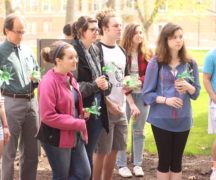By DAVID DUPONT
BG Independent News
The Creation Care Celebration, which marked the beginning of Earth Week activities in Bowling Green, focused on the possibilities.
Honored by the Black Swamp Green Team, the event’s sponsors, were those who were already making a difference locally, and statewide. The keynote speaker spoke about what churches could do to preserve the environment. And a series of workshops were offered on household options for taking action.
Stumbling blocks were mentioned – the state’s renewable energy standards are on hold.
But the two state legislators in attendance State Senator Randy Gardner and State Representative Tim Brown, both Republicans said they were in favor of lifting the hold on them and letting them take effect.
The keynote speaker Greg Hitzhusen of Ohio State University’s School of Environment & Natural Resources, spoke of a pastor in Idaho who took the initiative to put saving the environment at the center of his church’s mission. He discovered, Hitzhusen said, less resistance than he expected. Now 10 years later he’s experiencing fierce backlash to his efforts.
“How do we overcome these obstacles?” Hitzhusen wondered.
The speaker, who is involved in the Interfaith Light and Power movement, focused his talk on what works. “Build on your strengths,” he said. That means finding what expertise is within the congregation that can spearhead efforts.
The United Church of Christ in Sylvania used the expertise of Al Compaan, a leading researcher in photovoltaics, to initiate a solar project.
“Do what makes sense for your community,” he said.
Even simple measure can help. Saving money on energy can help a church keep its doors open and support its other missions, he said.
“When we learn about energy savings in our houses of worship,” he said, “we can learn to save energy in our households.”
But he faced his own obstacles in pursuing his vocation of blending faith with environmentalism. Raised a Presbyterian, he had a beloved pastor warn him about the “blue demon.” The pastor was concerned that concentrating on environmental ministry would lead to “the temptation toward nature worship.”
Hitzhusen went to Yale, the only school where he could blend his two passions. Later he planned to travel to Colorado where the pastor now served to discuss the matter with him. On the day he arrived, he learned the minister had just died. Hitzhusen attended the service and he noticed the Bible open to the eighth chapter of Paul’s Letter to the Romans. The passage is often cited at Christian funerals. Hitzhusen’s eye slipped lower in the chapter where it speaks of “the entire creation is groaning.”
Hitzhusen took this as a sign that he was headed in the right direction.
The celebration, held at Peace Lutheran Church, also included honoring those helping the city move in the right direction.
The City of Bowling Green was recognized for its myriad efforts toward a sustainable city. Those include the planned construction of a solar array this summer and the proposed implementation of complete streets.
Brown said that Daryl Stockburger, the municipal utilities director, was known in the state as “the father” of wind energy. Asked how ago he advocated for the wind turbines to be erected in the landfill, Stockburger responded, “long enough to be the grandfather of wind power.”
Bowling Green State University was recognized for signing on the Climate Action Plan, along with colleges and universities, across the country. The goal is for the university to be carbon neutral by 2040. Nick Hennessy, the director of sustainability, called that “a very aggressive goal.”
The Kiwanis Club of Bowling Green was recognized for its efforts to promote home energy audits. David Kuebeck who accepted on behalf of the club praised Neocles Leontis’ efforts to push for the audits, which show people how they can make their homes more energy efficient.
Brown and Gardner were recognized for their efforts in Columbus. Brown said one of the issues facing them was a house bill that would change setback requirements for wind energy farms. The current regulations are too restrictive, he said. Older setback requirements should be reinstated, he said.
One proposed wind farm is being held up. Planned for 152 turbines, under the new setback requirements there would only be room for 12.
Gardner cited the need to be vigilant about maintaining the health of Lake Erie. “We are required as citizens to do what we can to protect our environment.”



